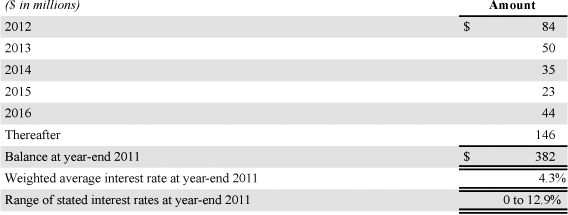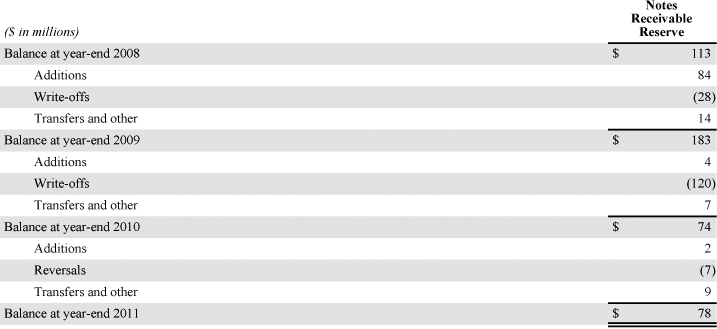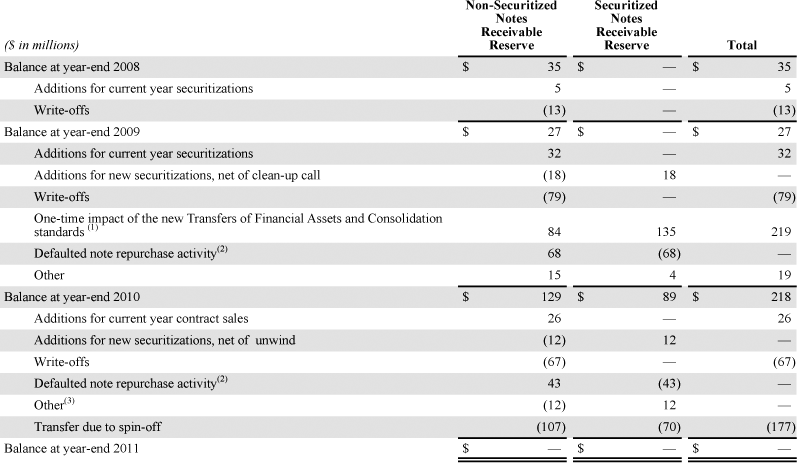MD&A
Quantitative and Qualitative Disclosures About Market Risk
Financial Statements
Notes to Financial Statements
Shareholder Return Performance Graph
Quarterly Financial Data
Selected Historical Financial Data
Non-GAAP Financial Measure Reconciliation
Management’s Reports
Reports of Independent Registered Public Accounting Firm
10. NOTES RECEIVABLE
We show the composition of our notes receivable balances (net of reserves and unamortized discounts) in the following table:

We classify notes receivable due within one year as current assets in the caption “Accounts and notes receivable” in our Balance Sheets. We show the composition of our long-term notes receivable balances (net of reserves and unamortized discounts) in the following table:

The following tables show future principal payments (net of reserves and unamortized discounts) as well as interest rates, reserves and unamortized discounts for our securitized and non-securitized notes receivable.
Notes Receivable Principal Payments (net of reserves and unamortized discounts) and Interest Rates

Notes Receivable Reserves

Notes Receivable Unamortized Discounts (1)

(1) The discounts for both year-end 2011 and 2010 relate entirely to our Senior, Mezzanine, and Other Loans.
Senior, Mezzanine, and Other Loans
We reflect interest income associated with “Senior, mezzanine, and other loans” in the “Interest income” caption in our Income Statements. At year-end 2011, our recorded investment in impaired “Senior, mezzanine, and other loans” was $96 million. We had a $78 million notes receivable reserve representing an allowance for credit losses, leaving $18 million of our investment in impaired loans, for which we had no related allowance for credit losses. At year-end 2010, our recorded investment in impaired “Senior, mezzanine, and other loans” was $83 million, and we had a $74 million notes receivable reserve representing an allowance for credit losses, leaving $9 million of our investment in impaired loans, for which we had no related allowance for credit losses. During 2011 and 2010, our average investment in impaired “Senior, mezzanine, and other loans” totaled $89 million and $137 million, respectively.
The following table summarizes the activity related to our “Senior, mezzanine, and other loans” notes receivable reserve for 2009, 2010, and 2011:

As of year-end 2011, past due senior, mezzanine, and other loans totaled $8 million.
Loans to Timeshare Owners
On November 21, 2011, we transferred all balances related to loans to timeshare owners (both securitized and non-securitized) to MVW as part of the spin-off. See Footnote No. 17, “Spin-off” for additional information. Prior to the spin-off date, we reflected interest income associated with “Loans to timeshare owners” of $143 million, $187 million, and $46 million for 2011, 2010 and 2009, respectively, in our Income Statements in the “Timeshare sales and services” revenue caption. Of the $143 million of interest income we recognized in 2011, $116 million was associated with securitized loans and $27 million was associated with non-securitized loans, compared with $147 million associated with securitized loans and $40 million associated with non-securitized loans in 2010. The interest income we recognized in 2009 related solely to non-securitized loans.
The following table summarizes the activity related to our “Loans to timeshare owners” notes receivable reserve for 2009, 2010, and 2011 prior to the spin-off date:

(1) The non-securitized notes receivable reserve related to the implementation of the new Transfers of Financial Assets and Consolidation standards, which required us to establish reserves for certain previously securitized and subsequently repurchased notes held at January 2, 2010.

(2) Decrease in securitized reserve and increase in non-securitized reserve was attributable to the transfer of the reserve when we repurchased the notes.

(3) Consisted of static pool and default rate assumption changes.
We show our recorded investment in nonaccrual “Loans to timeshare owners” loans at year-end 2010 (which were loans that were 90 days or more past due) as well as our average investment in these loans during 2010 in the following table:

